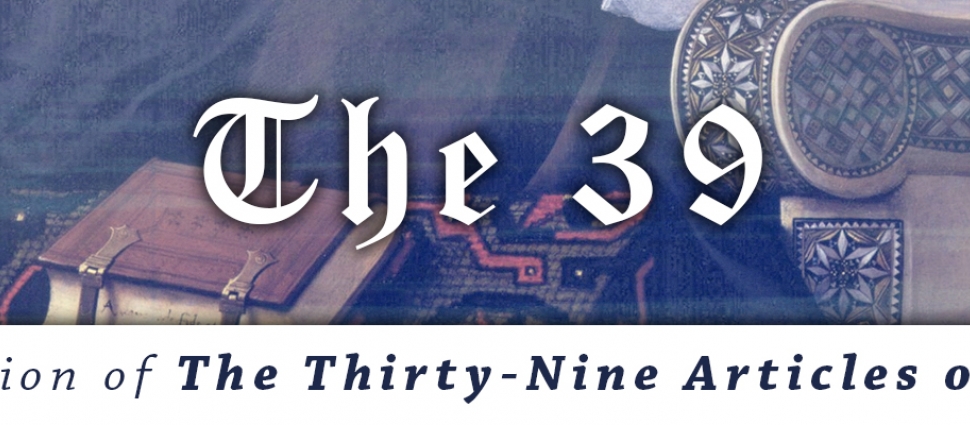The 39: The Sacraments (1)

May 11, 2018
The Thirty-nine Articles continue its narrative as it sets out a biblically faithful theology of God’s ordained means of grace in the sacraments. As we have seen in our study of other essential doctrines, the article begins with the general principles of the doctrine before continuing to a more specific examination. Articles 25 and 26 set out the general principles while articles 27-31 examine the specifics of Baptism and the Lord’s Supper. It is not an exaggeration to write that articles 27-31 have become the most controversial among Anglicans since the 1830’s, guaranteed to fill Anglican discussion on social media within minutes. Indeed, if one were to imagine the Anglican equivalent of a red-rag to a bull, these articles are the ones that are today either championed, deplored, or simply ignored as “the Anglican response to certain doctrinal issues controverted at that time” (Anglican Church in North America, Constitution & Canons 1.7). Why are they so controversial? The answer is obvious. They are the consequence of the doctrines that have preceded them.
XXV—Of The SacramentsSacraments ordained of Christ be not only badges or tokens of Christian men’s profession, but rather they be certain sure witnesses, and effectual signs of grace, and God’s good will towards us, by the which he doth work invisibly in us, and doth not only quicken, but also strengthen and confirm our Faith in him.There are two Sacraments ordained of Christ our Lord in the Gospel, that is to say, Baptism, and the Supper of the Lord.Those five commonly called Sacraments, that is to say, Confirmation, Penance, Orders, Matrimony, and extreme Unction, are not to be counted for Sacraments of the Gospel, being such as have grown partly of the corrupt following of the Apostles, partly are states of life allowed in the Scriptures; but yet have not like nature of Sacraments with Baptism, and the Lord’s Supper, for that they have not any visible sign or ceremony ordained of God.The Sacraments were not ordained of Christ to be gazed upon, or to be carried about, but that we should duly use them. And in such only as worthily receive the same they have a wholesome effect or operation: but they that receive them unworthily purchase to themselves damnation, as Saint Paul saith.
Cranmer’s original 1553 was revised in its structure and length in 1563 and in 1571 that resulted in a more clearly written capture of Cranmer’s thought. In 1563 Cranmer’s 1553 final paragraph became the first paragraph of the revision (Sacraments ordained of Christ…), a new second (There are two Sacraments…) and third paragraph (Those five commonly…) were also added. The 1563 second paragraph is a slight revision of Cranmer’s original first paragraph. Then in 1571 most of Cranmer’s original second and third were restored in what became the last paragraph of the article of today (The Sacraments were not…).
The article begins with a negative. The sacraments are “not only badges or tokens of Christian men's profession.” The wording is usually associated with the Zurich Reformer, Ulrich Zwingli. But one considers the 1553 context of Cranmer’s original Forty-two Articles, the reference is to the prevalent Anabaptist view rather than Zwingli’s more nuanced doctrine. They are “certain sure witnesses” that proclaim the gospel promises to us through our other senses. And “effectual signs of grace” to those who receive them with a believing heart. Notice how Archbishop Parker’s revision of Cranmer further strengthens the reformed character of the doctrine: the sacrament is only effective if the recipient has faith. They are Christ’s ordinary means of encouraging and strengthening the believer’s faith, particularly in times of difficulty, doubt, or despair. Rome and those who have been influenced by its teaching understand that the administration of the visible sign is a guarantee that the inward grace is made real in the recipient. If one were to favor the Roman view the balance of the article makes no sense.
By 1563 it was a matter of historical record that Cranmer consistently defended the Reformed view in his disputation with Bishop of Winchester Stephen Gardiner concerning the nature of our eating and drinking the Supper. We can also see how keeps a consistent Chalcedonian Christology we examined in article 2. God alone is infinite. No other creature possesses this attribute. Humans are finite. The reformed Christological position holds to the principle that the finite (humanity) cannot comprehend or attain the infinite (divinity). The finite cannot comprehend the infinite, even in the person of Christ. To do so robs Jesus of his true humanity and his office as our Mediator. The Lord Jesus having retained the attributes of his human nature has ascended. He, therefore, cannot be present locally but can be present truly by the Holy Spirit who proceeds from the Father and the Son (Article 5). One can hear in Cranmer echoes of John Calvin's description of how the sacraments are spiritual food for spiritual people:
These things before rehearsed are sufficient to prove, that the eating of Christ’s flesh and drinking of his blood, is not to be understood simply and plainly, as the words do properly signify, that we do eat and drink him with our mouths; but it is a figurative speech spiritually to be understand, that we must deeply print and fruitfully believe in our hearts, that his flesh was crucified and his blood shed, for our redemption. And this our belief in him, is to eat his flesh and to drink his blood, although they be not present here with us, but be ascended into heaven [Cranmer, Works, 115-116].
The article also says that the sacraments are "ordained of Christ," to be "duly used." To be "ordained of Christ" and to be "duly used" references article 19 on the nature of the church, that the sacraments are to be “duly ministered according to Christ’s ordinance." Modern distinctions like “Sacrament of the Gospel” and “Sacrament of the Church” are to be avoided as being misleading, diminishing Christ’s sole authority as our Head. There are just two sacraments expressly commanded by the Lord Jesus Christ in the New Testament, to which the promise of forgiveness of sin and union with him is signified: baptism and the Lord’s Supper. The term “sacrament” requires no further distinction. Those wrongly called “sacraments” by the man or woman on the street in the 16th century (“Those five commonly called ‘sacraments…’” Quinque illa vulgo nominata sacramenta): absolution, confirmation, ordination, matrimony, and extreme unction, lack the express command of the Lord Jesus or signify forgiveness of sin and union with him.
In St. Paul’s warning of 1 Corinthians 11 that unworthily received (i.e., without belief and trust in Christ's substitutionary atoning death for us) they add to our condemnation. Cranmer repeated this warning in all three versions of the Book of Common Prayer's "Exhortation" before receiving the Supper, "For as the benefit is great if with true penitent heart and lively faith we receive that holy Sacrament; (for then we spiritually eat the flesh of Christ and drink his blood) …So is the danger great, if we receive the same unworthily". Likewise, Cranmer's words of administration in the 1552 Book of Common Prayer service expresses this simple yet profound doctrine: “Take and eat this in remembrance that Christ died for thee, and feed on him in your heart by faith with thanksgiving."
The article closes with a prohibition. The sacraments are not to be thought of as objects in and of themselves, but to be thought of as a means of God's grace. Therefore, the 1552 instruction at the end of the Lord's Supper grants the minister the right to take the bread home for his table, and the 1662 revision of the rubric by the Restoration Bishops instruct that the leftover elements be consumed after the divine service. Being contrary to the Scriptures, there is no justification to do anything else with them.
Meet the Puritans is a conversation of the Alliance of Confessing Evangelicals. It is supported only by its readers and gracious Christians like you. Please prayerfully consider supporting us.
For previous articles in this series, see:
- Introduction
- One God in Trinity, Trinity in Unity (Art. 1)
- The Incarnation and Atonement (Art. 2)
- The Work of Christ (Arts. 3-4)
- The Holy Spirit (Art. 5)
- The Rule of Faith: Part 1 (Art. 6)
- The Rule of Faith: Part 2 (Art. 7)
- The Rule of Faith: Part 3 (Art. 8)
- Guilt, Grace, and Gratitude: Part 1 (Art. 9)
- Guilt, Grace, and Gratitude: Part 2 (Art. 10)
- Guilt, Grace, and Gratitude: Part 3 (Art. 11)
- Guilt, Grace, and Gratitude: Part 4 (Art. 12)
- Guilt, Grace, and Gratitude: Part 5 (Arts. 13-14)
- Guilt, Grace, and Gratitude: Part 6 (Art. 15)
- Guilt, Grace, and Gratitude: Part 7 (Art. 16)
- Grace Alone! (Art. 17)
- Christ Alone! (Art. 18)
- The Visible and Invisible Church: Part 1 (Art. 19)
- The Visible and Invisible Church: Part 2 (Art. 20)
- The Visible and Invisible Church: Part 3 (Art. 21)
- The Visible and Invisible Church: Part 4 (Art. 22)
- The Visible and Invisible Church: Part 5 (Art. 23)
- The Visible and Invisible Church: Part 6 (Art. 24)





